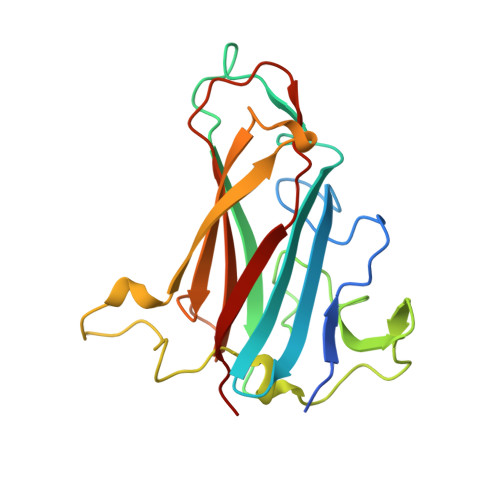Triazole linker-based trivalent sialic acid inhibitors of adenovirus type 37 infection of human corneal epithelial cells.
Caraballo, R., Saleeb, M., Bauer, J., Liaci, A.M., Chandra, N., Storm, R.J., Frangsmyr, L., Qian, W., Stehle, T., Arnberg, N., Elofsson, M.(2015) Org Biomol Chem 13: 9194-9205
- PubMed: 26177934
- DOI: https://doi.org/10.1039/c5ob01025j
- Primary Citation of Related Structures:
4K6T, 4K6U, 4K6V, 4K6W, 4XQA, 4XQB - PubMed Abstract:
Adenovirus type 37 (Ad37) is one of the principal agents responsible for epidemic keratoconjunctivitis (EKC), a severe ocular infection that remains without any available treatment. Recently, a trivalent sialic acid derivative (ME0322, Angew. Chem. Int. Ed., 2011, 50, 6519) was shown to function as a highly potent inhibitor of Ad37, efficiently preventing the attachment of the virion to the host cells and subsequent infection. Here, new trivalent sialic acid derivatives were designed, synthesized and their inhibitory properties against Ad37 infection of the human corneal epithelial cells were investigated. In comparison to ME0322, the best compound (17a) was found to be over three orders of magnitude more potent in a cell-attachment assay (IC50 = 1.4 nM) and about 140 times more potent in a cell-infection assay (IC50 = 2.9 nM). X-ray crystallographic analysis demonstrated a trivalent binding mode of all compounds to the Ad37 fiber knob. For the most potent compound ophthalmic toxicity in rabbits was investigated and it was concluded that repeated eye administration did not cause any adverse effects.
Organizational Affiliation:
Department of Chemistry, Umeå University, SE90187 Umeå, Sweden. [email protected].


















